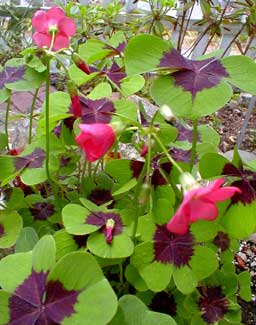
'Iron Cross' Oxalis;
or, False Shamrock
"Lying on the top of the salt-box was a bunch of fairy flax, & sewed in the folds of her own scapular was the dust of what had once been a four-leaved shamrock, an invaluable specific "for seein' the good people," if they happened to come within the bounds of vision."
-The Lianhan Shee
by Will Carleton
(1845-1912)
by Will Carleton
(1845-1912)
I obtained this as a start off of a large potted oxalis, the species unknown to the owner, so I had to look up & read about all sorts of oxalis before I was certain it was Oxalis deppei (aka O. tetraphylla speciosa).
Before identifying it I'd already planted it in a shade garden since the majority of oxalis seem to enjoy moist shade. Then upon identifying it, I quickly moved it to a sunny spot at the edge of a garden under the pin oak.
Iron Cross Oxalis wants a lot of sunlight & only a moderate amount of shade. Though tolerant of wetness, it is from Mexico & enjoys a hot, even somewhat droughty summer. The garden between the pin oak & the rohani beach is well-watered, but this oxalis is placed on the very ledge of a step-down to insure it gets the complete drainage & occasional dryness it prefers.
Unlike many types of oxalis it is not invasive, though garden hardy even in a temperate zone. There are several non-invasive hardy species that deserve greater popularity for beauty & for their ease of growth, but the invasiveness of certain other wild Wood Sorrels has caused a prejudice against the whole genus in too many gardeners' minds.
C. deppei was introduced to European gardening in Victorian times. The cultivar name is derived from the maroon cross formed at the center of the four bright green-rimmed velvety leaves. Throughout summer & into early autumn (June through September or later, until first frost or longer) it has big bright pink flowers. The species as opposed to the cultivar has less impactful flowers & not so strong a cross pattern, so the select variety "Iron Cross" is deservedly more popular.
Even if it never flowered the foliage is so gorgeous it belongs in the garden. That it also flowers for quite a long time just adds to its excellence. There must be two distinct strains of "Iron Cross" though no reference alludes to it, but some produce almost crimson flowers they're so darkly pink, whereas others, including the one we have, possess large pale pink blooms, the color of the blushed part of a peach. The flowers are trumpet-shaped, & the unusual buds look like little umbrellas. Hard to get more charming than that!
Any oxalis species that has the four leaves inevitably will bear such common nicknames as Good Luck Shamrocks (or False Shamrocks), Lucky Clover, or Four Leaved Clover Plants, & O. deppei has been called all these.
The leaves & flowers have a lemony taste decoratively suitable for salads. The tartness is due to oxalic acid, found also in rhubarb & spinach. If eaten in large amounts daily, it can be mildly toxic, suppressing proper calcium absorption; but a few leaves now & then, & a couple of the flowers together with flowers from a nasturtium patch, can really brighten up a dinner salad, & is perfectly safe. Flowers, seeds, & leaves are also fine as cooked greens, though when cooked they mush up & loose their visual charm. The mildly acidic roots & corms are also edible cooked or raw, though not as flavorful as the leaves & flowers.
When grown in the warm south, O. deppei is evergreen. In our temperate area, during its first winter in our garden, it remained fairly decent looking until well into winter, though it finally did go dormant, & is slow to return, showing itself at the tail end of spring, & beginning to bloom again in July.